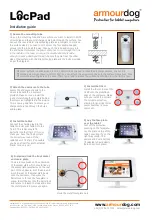
Stationary VRLA Batteries,
Installation and Operation Instructions
Page 11 of 16
w w w. b a e b a t t e r i e s u s a . c o m
R e v : 0 2 1 9
Although not necessary for initial commissioning, some users have standard
commissioning processes with a 24 to 72 hour equalize charge for their strings
prior to placing them into service. This equalize charge will not harm the battery.
7.0.2 COMMISSIONING WITH HIGHER CHARGING VOLTAGES - 2.33 to 2.40 VPC
Place the batteries into service on equalize charge at 2.33 to 2.40 VPC. After a
period of 24 to 72 hours the batteries should be in a fully charged condition.
8.0 INSTRUCTIONS FOR OPERATION
This section provides the operating instructions and detailed behavior of the BAE VRLA
lead-acid batteries.
The instructions for operation and maintenance contained in subsequent sections should
be combined or may be supplemented by site specific detailed procedures for necessary
testing and inspections. Special testing may be required under certain conditions (DIN,
VDE, and KTA for export) and IEEE for domestic applications as set forth by the user.
8.1 FLOAT CHARGING
BAE Stationary lead-acid storage batteries are designed so that optimum life and
available capacity are achieved with a float voltage of 2.25 VPC +/- 1% between 10°C
(50°F) and 30°C (86°F).
Total string float voltage will be 2.25 V x number of cells +/-1% nominal.
Higher or lower charging voltages can be detrimental as overcharging or undercharging
will reduce the batteries life expectancy.
8.2 EQUALIZATION CHARGING
Under normal circumstances equalizing charges are not required for VRLA batteries.
If there are unacceptably large discrepancies between the individual cell voltages at float
charge, after deep discharges, or after inadequate recharging, equalizing charging is
necessary. This may be carried out as follows:
a) At an increased voltage of (2.33 to 2.40 V) x number of cells up to a maximum of 72
hours.
b) At currents according to the Section 8.3 Charging Currents below
Because it is possible to exceed the permitted load voltages, appropriate measures must
be taken, e.g. switch off the load.
If the maximum temperature of 45°C (113
°
F) is exceeded, the charging must be stopped
or switched to float charge to allow the temperature to drop.
The equalize charge is completed when the single cell voltages do not increase for two
consecutive hours.
Lower equalize voltages increase the equalize duration but decrease the gas emissions
generated.
8.3 CHARGING CURRENTS
The charging current on the BAE cells does not need to be limited until the battery
voltage has reached 2.40 VPC x number of cells - thereafter the charging current has to
be limited to 1.5A per 100 Ah of battery capacity.



































